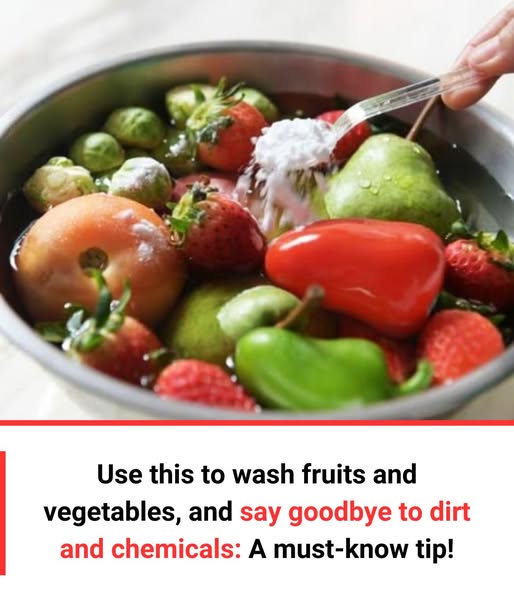ADVERTISEMENT
Step-by-Step Guide to Washing Produce
Now that you know what you need, let’s go over the best method for washing your fruits and vegetables effectively:
1. Rinse with Water
Start by rinsing your produce under cool running water. This simple step can remove dirt, loose pesticides, and bacteria from the surface. Make sure to rinse each piece individually, especially if it has crevices, like strawberries or broccoli.
2. Soak in a Baking Soda Solution
For a more thorough cleaning, create a soaking solution with baking soda. Simply fill a large bowl or basin with water and add about 1 teaspoon of baking soda per cup of water. Soak your produce for about 5-10 minutes. This helps remove pesticide residues and other contaminants that may not wash away with water alone.
- Tip: For leafy greens like spinach or lettuce, you can soak them in a baking soda solution to get rid of dirt and bacteria hiding in the folds of the leaves.
3. Use Vinegar for Extra Cleaning
For an extra layer of cleanliness, you can use white vinegar. Mix a solution of 1 part vinegar to 3 parts water in a bowl or spray bottle. For produce like apples, cucumbers, or grapes, spray or soak them in this vinegar solution for a few minutes. The vinegar helps kill harmful bacteria, remove wax coatings, and reduce pesticide residues.
- Tip: For delicate fruits like berries, don’t soak them in vinegar solution. Instead, lightly mist them or wash gently in a colander.
4. Scrub Firm Produce
For fruits and vegetables with thicker skins, such as potatoes, carrots, cucumbers, or squash, use a soft brush to scrub the surface. This helps dislodge dirt and ensures that you’re cleaning deep into the surface without damaging the produce.
- Tip: If you don’t have a vegetable brush, you can use a clean sponge or cloth to scrub away dirt from these items.
5. Rinse Thoroughly
After soaking or scrubbing, give your produce another rinse under cool water to wash away any remaining residue from the baking soda, vinegar, or dirt. Be sure to rinse thoroughly to ensure that all cleaning agents are removed.
6. Dry and Store Properly
Once your produce is clean, pat it dry with a clean towel or cloth. This helps remove any remaining water and prevents the growth of bacteria during storage. For leafy greens, consider using a salad spinner to remove excess water.
Additional Tips for Washing Produce
- Don’t Use Soap or Bleach: Avoid using dish soap or bleach to wash fruits and vegetables, as they can leave behind harmful chemicals that may not be safe for consumption.
- Wash Before Eating, Not Before Storing: It’s best to wash your produce right before eating or cooking rather than right when you bring it home from the store. This helps keep it fresh longer.
- Buy Organic When Possible: While washing helps remove a significant amount of pesticide residues, buying organic produce when possible can reduce your exposure to chemicals.
- Peel When Necessary: If you’re still concerned about pesticides on the skin, peeling fruits and vegetables like apples, cucumbers, and potatoes can further reduce your exposure.
Conclusion
By washing your fruits and vegetables properly, you can enjoy the health benefits of fresh, clean produce without the worry of harmful dirt, chemicals, or bacteria. Using simple ingredients like baking soda and vinegar, you can effectively remove pesticides, wax, and contaminants, ensuring that your fruits and vegetables are as safe and healthy as possible. So, the next time you bring fresh produce home, take the time to wash it properly and enjoy a cleaner, healthier meal!
ADVERTISEMENT
